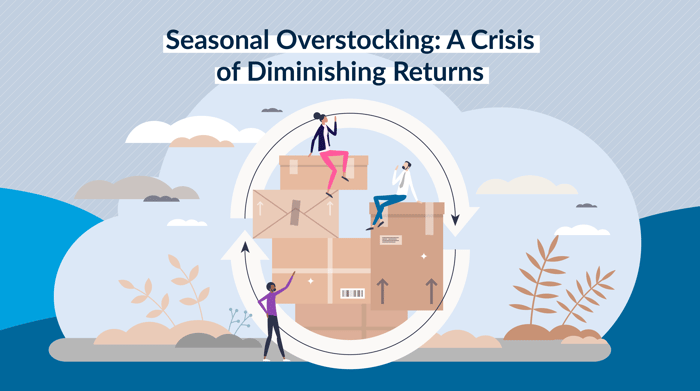Seasonal Overstocking: A Crisis of Diminishing Returns

Recent media coverage of returns may leave you wondering if a full-blown war has been declared between retailers and consumers. Overstocking had already left retailers with engorged inventories and mounting concerns before the threat of a deluge of returns provoked panic. Still, there is hope: With a few small changes to operations, a mutually beneficial treaty may be on the cards.
We previously gave you the lowdown on “bullwhip” and why overstocking has become so widespread, now it’s time to reassess the climate in light of holiday season sales.
Retailers Get Their Fill of Christmas Overstocking
There are encouraging signs: The Federal Reserve’s latest statistics show a 6% reduction in inventory and a record 196.7 million people shopped over Black Friday weekend. Unfortunately, that may not be enough. According to Deloitte, inventory woes are set to continue into 2023, so it’s essentially going to be “new year, same overstocking.”
After seeing record levels of discounting as a result of the ongoing inventory glut, consumers might not be so despondent. November saw an online price decrease of 3.2% from October and 1.9% when compared to November 2021. This was the largest drop in 31 months — not since May 2020 have prices decreased by so much.
Opinion is divided on what deep discounting means for the industry. Some claim it’s a last resort for desperate retailers, while others see it as a return to pre-pandemic norms and evidence of supply chain stability.
Return of the… Return
Even if lower prices provoke record spending this holiday season, an abundance of returns could throw a wrench in the works for the industry.
For consumers, returns are in vogue. A parcelLab survey found that Americans have sent back 47% of their online purchases this year. The global number of returns has also jumped up by 13% on 2021.
While free returns may bring consumers joy, their impact on the environment and business is significant. Some estimates put the cost to retailers at $15 per returned item. Sender Shamiss, Chief Executive at returns management provider goTRG, goes a step further when he describes products of $25 to $40 losing 80 to 90 percent of their value as a result of the returns process. Like a birthday party that no one turned up to, there aren’t many happy returns for retailers.
An Insider Intelligence report suggests that up to 26.5% of purchases will be returned this year and the National Retail Federation foresees the return of nearly $171 billion of goods just this holiday season. If these predictions come to pass, many businesses could go into 2023 with bloated inventories and impaired profits.
Retailers Strike Back
Up against the ropes, businesses are fighting back with a change of strategy. Over 60% of retailers are tightening their returns policies and reducing the time period consumers have to send products back.
Big chains like Zara, H&M, Abercrombie & Fitch and Anthropologie are charging $4 to $7.50 to restock merchandise or for a return label, and smaller businesses will surely be tempted to follow suit after crunching the numbers.
The problem is, while retailers are trying to make a point of no returns, consumers are now less willing than ever to compromise. In the aforementioned parcelLab survey, more than half of shoppers affirmed their belief that retailers should cover the cost of returns. Another survey by First Insight found that 75% of consumers would be deterred from shopping at a retailer that charges for returns.
So how can you make returns less damaging for your business without pushing consumers away?
A whopping 65% of shoppers prefer returning gifts to a physical store rather than sending them back through the mail, and appeasing these consumers could very well be the solution. Amazon certainly thinks so — it recently partnered with Staples to use their stores as in-person drop-off locations for product returns.
While your business might not have the same resources as Amazon, there is an affordable way to partner with retail stores for returns and significantly boost your ROI while you’re at it. Let us introduce you to Quivers.
A New Hope
Quivers connects specialty brands to local retailers and consumers to provide a streamlined, stress-free experience. By relying on retailers to handle the returns process, you save time, reduce shipping expenses and boost foot traffic for your partnering retailers.
Quivers’ omnichannel toolkit facilitates a form of collaborative commerce that helps you fulfill orders more flexibly, regardless of where the inventory sits. With Quivers, you can offer in-demand fulfillment options and substantially boost sales without making significant changes to your operations.
To learn more about how Quivers helps your brand in the battle against overstocking and returns, request a demo from us today.



.png?width=352&name=Sell-Through%20Challenges%20(2).png)